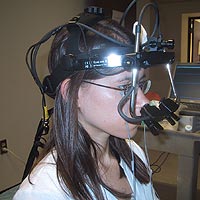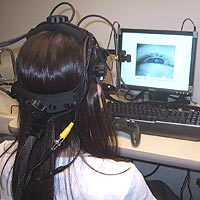Ergonomics research aims to help reduce visual demands of computer use
Researchers at Pacific University College of Optometry’s Vision Ergonomics Laboratory are investigating methods to optimize vision and reduce eye strain in computer users.
The Vision Ergonomics Laboratory, founded and led by the college’s dean, James E. Sheedy, OD, PhD, is conducting research on sponsored by the Microsoft Corporation on font design, text legibility and the effects of electronic devices on the vision of computer users.
Dr. Sheedy established the lab while teaching at Ohio State University, then moved it to Pacific University when he was offered the opportunity to be the dean of the optometry program. The mission of the lab, regardless of the location, remains the same.
“The Vision Ergonomics Lab is designed to study how we can optimize the vision of individuals and the designs of tasks to allow people to be as efficient and comfortable as possible,” Dr. Sheedy said in an interview with Primary Care Optometry News.
Research is funded by corporations looking to develop new products based upon the lab’s experimentation.
CVS: Causes and symptoms
Computer vision syndrome (CVS) is a common grievance of long-term computer users. Characterized by blurry vision, eye strain and headaches, CVS is a field that Dr. Sheedy has studied extensively in his career.
 |  |
The Eyelink Instrument measures and analyzes eye movements, especially during reading. Images: Sheedy JE | |
One of the reasons computer users experience CVS is the compromised text quality and its effects upon accommodation, binocular vision and eye movements. Computer displays are made of pixels (a contraction for “picture elements”), or small spots of light, and each pixel is composed of sub-pixels which are small vertical bars of red, green and blue light. Considerable research has been performed on separately addressing the sub-pixels in order to improve resolution.
The Vision Ergonomics Lab at Pacific University has been commissioned by the Microsoft Corporation’s font design group to research how to “allocate the pixels in a way that allows people to read text as smoothly and as comfortably as possible,” Dr. Sheedy said.
Text legibility studies
Researchers at the Vision Ergonomics Laboratory have been comparing text types to find the most legible. According to a recent study, it is not the outline of the word but rather the letters that make up the word that help individuals recognize it.
“There was a thought that the shape somehow contributed to the identification of the word, but that actually appears not to be the case. You need to see the individual letters,” Dr. Sheedy explained.
Because letters, and not just shapes, must be seen, the clarity of text on computer displays is an important factor in determining vision-safe font designs.
In a recent study conducted by the lab, the text legibility on six small, handheld electronic devices used for e-mail, internet, and personal use were tested. The results showed that individuals held the electronic devices closer to their eyes than they did printed cards with written text of the same style and size.
“The closer you hold something to your eyes, the more demanding it is on your visual system. You need to converge your eyes more and you need to accommodate more,” Dr. Sheedy said. “We can make Verdana smaller than any other font and people can still see it. Times New Roman is usually one of the poorest performers — you can’t make it as small as Verdana,” he said.
Text that is difficult to read strains the eyes and causes individuals to squint to make it more clear, thereby causing the discomfort associated with CVS.
Dr. Sheedy and his team are currently researching ways to combat illegibility and may have found a solution in the creation of Clear Type. The pixels in Clear Type have three times the resolution of standard pixels, meaning that each pixel has three bars of each color light instead of just one. This makes the text sharper and more critically defined, which provides a greater legibility of characters, he said.
Unfortunately, it is not without flaws. “Now you end up with bright colors on the edges of the letters,” Dr. Sheedy said. “So, we are using different algorithms to optimize the resolution-enhancing effects of Clear Type while avoiding the unwanted color effects,” he explained.
Future plans: The Vision Performance Institute
In the future, Dr. Sheedy sees the Vision Ergonomics Laboratory joining forces with other research groups at Pacific University College of Optometry.
“We have a sports vision group in our faculty; we have traditional expertise in binocular vision disorders and the effects on reading, especially in children,” he said. “We also have an excellent contact lens group. All of the research performed by these groups really falls under the term ‘performance.’ So, we are growing the Vision Performance Institute as a means of working cooperatively with corporations who are interested in vision performance.”
The researchers at the Vision Ergonomics Lab have been publishing their results in The Journal of the American Optometric Association, Practical Optometry, Behaviour & Information Technology, Optometry, Human Factors, and Optometry and Vision Science.
For more information:
- James E. Sheedy, OD, PhD, can be reached at Pacific University College of Optometry, 2043 College Way, Forest Grove, OR 97116; (503) 352-2884; fax: (503) 352-2261; e-mail: jsheedy@pacificu.edu.
